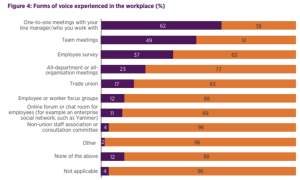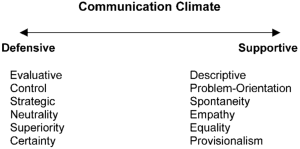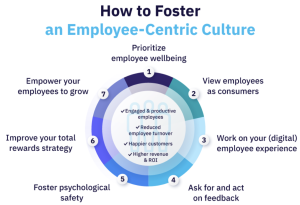Obvious though it may sound, when we listen to the thoughts, feelings, and concerns of employees, it’s a fantastic way to show that their wellbeing is being prioritized and makes them feel valued in their role.
And yet, while many more organizations are waking up to the potential benefits of upward communication, many are still not – even though the benefits of it aren’t just for employees, but their employers too.
Understanding upward communication
At it’s most simply, upward communication is the flow of information from lower-level employees to their superiors.
It is how team members communicate with upper management to share ideas, raise concerns, and provide feedback.
The counterpart of upward communication is downward [or ‘top down’], communication, where those at the top of an organization communicate with lower-level employees. Because downward communication usually provides instructions, assigns responsibilities, or establishes guidelines, it can is often be perceived negatively, or in an authoritarian way.
In contrast, upward communication is often more participative in nature. While downward communication has previously been thought to be one of the most important kinds of communication within an organization, recent years have seen upward communication rise in importance as employee-centric workplaces have become more prevalent.
Why? Because upward communication provide employees with a ‘voice’ in an organization.
Employees who feel they have a voice are more likely to feel valued and are more engaged and productive as a result.
The benefits of an enhanced employee voice
While executives are responsible for making most key business decisions, they won’t necessarily have the answer to every problem.
Lower-level employees often have the experience, the on-the-floor knowledge, and the know-how to solve a range of problems.
With a large number of employees and processes to overlook, it can often be difficult for upper management to remain apprised of every aspect of their organization. By gathering employee feedback, they can learn about potential issues in the business that may otherwise have gone unnoticed.
These could be small barriers to productivity, such as specific employees lacking a particular tool needed to perform in their role, or bigger obstacles that may affect the performance of the entire organization if left unchecked
Opening up communication with these employees helps organizations to gain more perspectives, which can be a valuable asset when making decisions.
The many types of ‘employee voice’
Upward communication through an effective employee voice can come via a number of means – see below.

Source: CIPD
However, employees are far less likely to engage in upward communication if they feel it is a performative gesture.
For upward communication to work, CHRO must show employees that they have also listened to the feedback given, and that steps are/will be taken to act upon it.

Source: Gallup
How to foster upward communication

Source: AIHR
Asking for- and acting upon employee feedback is one of the key building blocks of an employee-centric culture.
Once employees begin to see that their upward communication is being acknowledged, they’ll be more forthcoming in engaging in it.
It’s also important to make sure that employees feel they can share honest feedback without fear of reprisal.
They should feel empowered to share constructive criticism without the fear that any negative comments will be held against them in any way by their superiors.
Providing multiple communication channels
What is certain. however, is that if you’re asking your employees to communicate with you, you also need to provide them with the appropriate communication channels to do so.
Try to move away from one-way communications, such as company-wide email newsletters. While these have their place for distributing information across the entire organization, they aren’t suitable for engaging in upward communication, as they provide little opportunity for two-way interaction.
Instead, look to communication channels that invite participation in both directions.
Internal business messaging apps and collaborative document-sharing platforms can provide a way for supervisors and their subordinates to communicate backward and forwards, sharing ideas and offering feedback.
If you want to fully engage your employees, consider offering them channels for upward communication through which they prefer to communicate day-to-day.
For example, many employees prefer to communicate via email or telephone call, so making upward communication possible through these channels, perhaps even a local 646 area code phone number, will encourage more employees to participate.
It’s also a good idea to make face-to-face communication available as an option, as many employees prefer to interact in this way. Focus groups and one-to-one meetings provide a more personal way for employees to interact with their superiors, which can often make them feel that their feedback is actually being acknowledged.
Think of what you need to do like omni-channel vs. multi-channel communications: you’ll want all your channels working together to produce the desired results.
These channels may include:
- Employee satisfaction surveys: The quickest and easiest way to gather feedback from across the organization and allow employees to provide constructive criticism about their work environment and any barriers they feel are holding them back from performing well in their roles. Making these surveys anonymous helps employees to feel comfortable sharing their honest opinions.
- Focus groups: Mediated group sessions allow employees from different areas of the organization to share feedback, working collaboratively to highlight any opportunities for improvement. Focus groups are particularly helpful in gathering feedback on new rules, processes, procedures, and tools in the organization.
- Performance reviews: Holding regular performance reviews with employees is a great way to give them feedback, help, and advice. It also provides a forum for employees to provide feedback on the organization and upper management. Making these reviews a two-way conversation helps both parties to learn from each other and builds an environment of trust and respect.
Training and development programs
If you wish to establish upward communication within your organization, then it’s important to provide training and development programs that instill its importance in every participant.
Make sure that employees are aware of the channels available to them for upward communication and how they can access them.
It can be a good idea to provide examples of the kinds of communication you’re looking for and stress the importance of constructive criticism over destructive criticism.
Other ways to encourage employee voice
The free-flow of information from various sources can be facilitated by tools such as ERP software.
Enterprise resource planning software allows for the sharing of critical business data from across an organization and improves interaction between different teams and offices.
Being able to quickly and easily share information and ideas across an organization is a key aspect of upward communication and enables the improved decision-making and problem-solving it provides.
What you’ll get back
- Employee empowerment and engagement: Upward communication helps to contribute to the empowerment and engagement of your employees. Workers who feel they are able to raise concerns and provide feedback to upper management are more likely to feel valued in their role and feel more engaged as a result.
- Enhanced organizational culture and morale: An organization that encourages upward communication is more likely to foster a culture of collaboration and inclusiveness. This has the added benefits of increasing employee morale, boosting employee engagement, and reducing employee churn.
- Cross-departmental collaboration: Upward communication can be instrumental in building a collaborative culture for employees, making them feel valued, and helping them to be more engaged and productive as a result.
- You’ll create a supportive communication climate: Upward communication creates a supportive communication climate built around empathy and equality, will all employees feeling like they have a platform to speak and that they’ll be heard.
- Engagement: Higher employee engagement has a range of benefits. Engaged employees are less likely to be absent from work, are less likely to be involved in safety incidents, and are less likely to produce low-quality work.
Conclusions:
Building a company culture that promotes upward communication doesn’t happen overnight.
But, including a more diverse range of knowledge and opinions in the decision-making and problem-solving processes will lead to better innovation and results in more informed decisions being made.
Upward communication also helps to foster organizational alignment. This makes sure that all employees are aware of the overall goals of the organization and can take actions that help to achieve them.
Creating a supportive communication climate, providing relevant communication channels, and implementing comprehensive training and development programs are the best ways to make sure that upward communication is implemented effectively and that its many benefits can be seen as quickly as possible.
An organization that encourages upward communication is more likely to foster a culture of collaboration and inclusiveness.
This has the added benefits of increasing employee morale, boosting employee engagement, and reducing employee churn.
